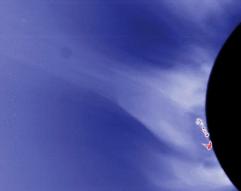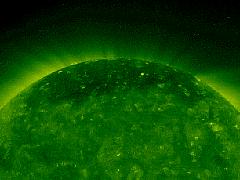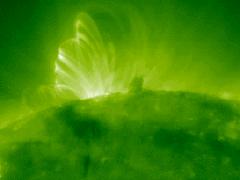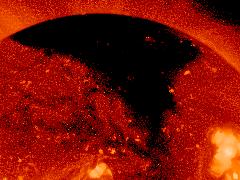 |
Click on image for larger version. |
|
Helmet streamers are large cap-like coronal structures with long pointed
peaks that usually overlie sunspots and active
regions. We often find a prominence or filament lying at the base of these structures. Helmet
streamers are formed by a network of magnetic loops that connect the sunspots in active
regions and help suspend the prominence material above the solar surface. The closed
magnetic field lines trap the electrically charged coronal gases to form these relatively
dense structures. The pointed peaks are formed by the action of the solar
wind blowing away from the Sun in the spaces between the streamers.
|
 |
Click on image for larger version. |
|
Polar plumes are long thin streamers that project outward from the Sun's
north and south poles. We often find bright areas at the footpoints of these features that
are associated with small magnetic regions on the solar surface. These structures are
associated with the "open" magnetic field lines at the Sun's poles. The plumes
are formed by the action of the solar wind in much the same way as the peaks on the helmet
streamers.
|
 |
Click on image for larger version. |
|
Coronal loops are found around sunspots and in active regions. These
structures are associated with the closed magnetic field lines that connect magnetic
regions on the solar surface. Many coronal loops last for days or weeks but
most change quite rapidly (10
Mb Quicktime movie from TRACE observations). Some loops,
however, are associated with solar flares and are visible for
much shorter periods. These loops contain denser material than their surroundings. The three-dimensional structure and the dynamics of these loops is an
area of active research.
|
 |
Click on image for larger version. |
|
Coronal holes are regions where the corona is dark. These features were
discovered when X-ray telescopes were first flown above the earth's atmosphere to reveal
the structure of the corona across the solar disc. Coronal holes are associated with
"open" magnetic field lines and are often found at the Sun's poles. The
high-speed solar wind is known to originate in coronal holes.
|





